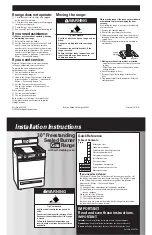
37
Lift-Off Oven Door
The oven door is removable, but it is heavy.
You may need help removing and replacing
the door.
To remove the door,
open it a few inches
to the special stop position that will hold the
door open. Grasp firmly on each side and lift
the door straight up and off the hinges.
NOTE:
Be careful not to place hands between
the hinge and the oven door frame as the
hinge could snap back and pinch fingers.
To replace the door,
make sure the hinges
are in the special stop position. Position the
slots in the bottom of the door squarely over
the hinges. Then lower the door slowly and
evenly over both hinges at the same time. If
the hinges snap back against the oven frame,
pull them back out.
To clean the inside of the door:
■
Do not allow excess water to run into
any holes or slots in the door.
■
Because the area inside the gasket is
cleaned during the self clean cycle, you do
not need to clean this by hand. Any soap
left on the liner causes additional stains
when the oven is heated.
■
The area outside the gasket can be
cleaned with a soap-filled plastic
scouring pad.
To clean the outside of the door:
■
Use soap and water to thoroughly clean
the top, sides and front of the oven door.
Rinse well. You may also use a glass
cleaner to clean the glass on the outside
of the door.
■
Spillage of marinades, fruit juices, tomato
sauces and basting materials containing
acids may cause discoloration and should
be wiped up immediately. When the
surface is cool, clean and rinse.
■
Do not use oven cleaners, cleansing
powders or harsh abrasives on the
outside of the door.
Lift the door straight up and off
the hinges.
The gasket is designed with a gap
at the bottom to allow for proper air
circulation.
Do not rub or clean the door gasket—
it has an extremely low resistance to
abrasion.
If you notice the gasket becoming worn,
frayed or damaged in any way or if it
has become displaced on the door, you
should have it replaced.
GEAppliances.com
C
o
n
su
m
e
r
S
u
p
p
o
rt
O
p
e
ra
tin
g
In
st
ru
c
tio
n
s
S
a
fe
ty
In
st
ru
c
tio
n
s
In
st
a
lla
tio
n
In
st
ru
c
tio
n
s
T
ro
u
b
le
sh
o
o
tin
g
T
ip
s
Oven Bottom
The oven bottom has a porcelain enamel
finish. To make cleaning easier, protect the
oven bottom from excessive spillovers by
placing a cookie sheet on the rack below the
rack you are cooking on. This is particularly
important when baking a fruit pie or other
foods with a high acid content. Hot fruit
fillings or other foods that are highly acidic
(such as tomatoes, sauerkraut and sauces
with vinegar or lemon juice) may cause
pitting and damage to the porcelain enamel
surface and should be wiped up immediately.
We don’t recommend using aluminum foil on
the oven bottom. It can affect air flow if the
holes are blocked and it can concentrate heat
at the bottom of the oven, resulting in poor
baking performance.
To clean up spillovers, use soap and water, an
abrasive cleaner or soap-filled scouring pad.
Rinse well to remove any soap before self-
cleaning.
Oven Racks and Drawer Racks
The gray porcelain-coated racks may be
cleaned in the oven during the self-clean
cycle.
They may also be cleaned by using an
abrasive cleanser. After cleaning, rinse the
racks with clean water and dry with a clean
cloth. If the racks ever become hard to slide,
wipe the rack edges or oven rack supports
with vegetable oil.
Summary of Contents for Cafe CGS980SEMSS
Page 56: ...56 ...
















































